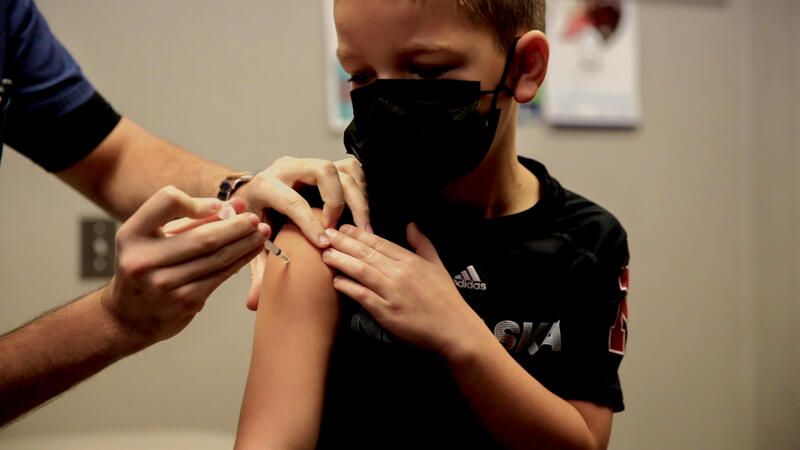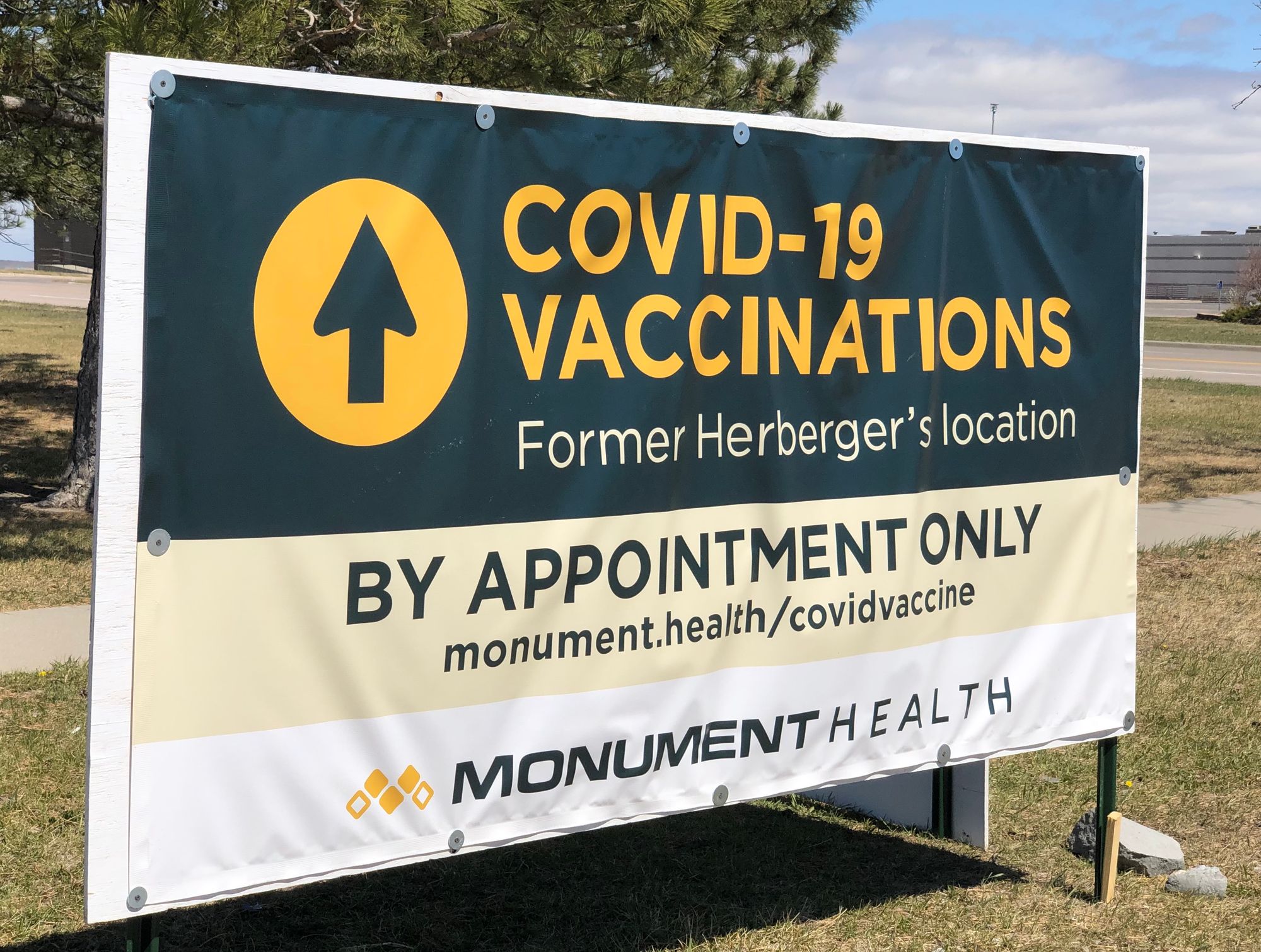As COVID-19 infections sweep across South Dakota in record numbers, concerns are rising that children and adolescents are suffering more severe illness than before and may be susceptible to symptoms that can afflict them long into their lifetimes.
A growing body of medical research and reports from pediatricians in South Dakota indicate that some children who test positive and overcome the initial coronavirus infection are suffering the same lingering, sometimes debilitating symptoms as adults who had COVID-19.
Symptoms that can occur in children well after initial infection with COVID-19 include respiratory problems, cognitive defects, chronic fatigue, headaches and loss of senses of smell or taste.
Doctors in South Dakota have seen a recent increase in the number of children who are suffering from severe symptoms of COVID-19 immediately and shortly after infection. In early 2022, South Dakota saw the first deaths of children with COVID-19 — one an infant in Pennington County and another from Minnehaha County who was 10 or under, according to state health officials.
The condition known as “Long-COVID,” and patients with lingering symptoms who are referred to as “long-haulers,” are well documented among adults who have had COVID-19.
But researchers in America and across the world are increasingly concerned that children who get COVID-19 could face similar long-range symptoms that may inhibit their ability to live normal or fruitful lives.
“I don’t know how big of a piece of the pie that is, but certainly we have patients who are young and have developed long-hauler symptoms,” said Dr. Chad Thury, a family physician who is also regional director of clinical quality at Avera Health in Sioux Falls. “Whether that’s altered taste and smell and they can’t eat and start to lose weight because everything tastes rancid, or it is ‘brain fog’ or not being able to think clearly.”
With the COVID-19 pandemic starting only two years ago, it is hard to say now if infected children will have symptoms later in life. But Thury said it is worrisome that long-hauler symptoms once seen only in adults are now being seen in children.
“The general fatigue and malaise, those we see pretty often in kids,” he said. “Those can last a number of weeks after a COVID infection.”

"Certainly we have patients who are young and have developed long-hauler symptoms ... the general fatigue and malaise, those we see pretty often in kids [and] those can last a number of weeks after a COVID infection." -- Dr. Chad Thury, Avera Health
As cases of COVID-19 among children have continued to rise, especially since the highly transmissible omicron coronavirus variant became dominant in the U.S. last year, more children have ended up in the hospital with serious and sometimes long-range symptoms, said Dr. Jody Huber, a pediatrician and head of children’s intensive care at Sanford Health in Sioux Falls.
“It has been alarming for us,” Huber said. “What we have seen with this current variant is that we have had more children hospitalized with COVID than we ever have before.”
As of Jan. 19, 2022, the South Dakota Department of Health reported that 13,456 children ages 0-9 have had COVID-19 so far in the state, and 25,853 residents ages 10-19 have been infected. About 235 people in those age ranges have been hospitalized, with two deaths reported.
In response to increasing rates of COVID-19 among children and more children with serious symptoms, Huber said Sanford has opened a new intensive care wing of the hospital specifically for children with COVID-19.

Vaccination can limit COVID infection, symptoms
Doctors across the country have consistently seen the benefits of vaccines to fight COVID-19 among children, both in preventing infection and reducing the chance of experiencing serious or lingering symptoms.
“What we’re noticing, especially right now with the new omicron wave, is that children who are vaccinated have less severe illness than unvaccinated children,” Huber said.
Thury said vaccination also appears to help children avoid symptoms that linger after initial recovery from COVID-19.
“In terms of long-haulers, there’s pretty clear evidence that being vaccinated prevents that,” he said.
Vaccines are available to people age 5 and up; as of mid-January, South Dakota was slightly behind the national average of vaccination rates of children and adolescents.
Getting vaccinated also appears to reduce the chance that infected children will get multi-inflammatory syndrome, which can be debilitating, Huber said.
MIS-C is a condition in which several body parts can become inflamed, including the heart, lungs, kidneys, brain, skin, eyes, or gastrointestinal organs, according to the federal Centers for Disease Control and Prevention. The condition has been diagnosed in more than 6,000 U.S. children who had COVID-19 or were exposed to someone with the active virus. Several cases have been documented in South Dakota.

“So we’re encouraging all parents to get their children vaccinated against COVID-19,” Huber said.
Thury said vaccines not only protect individuals, they also protect the population of adults and children at large.
Thury said a high rate of vaccination among children and young adults is a critical component of reaching so-called herd immunity, or the condition in which the virus is unable to spread with regularity among the general population and life can begin to return to normal. Herd immunity will also reduce the likelihood of future surges in COVID-19 cases and reduce the chance of outbreak of virus variants, which create new health concerns or, as with omicron, can be more transmissible than other virus variants, Thury said.
“Kids and young adults are a big propagator and spreader of COVID, and getting them vaccinated is part of the solution to both problems,” he said.
Greater vaccination rates will also help protect people who are immuno-compromised or who are unable to get vaccinated for some health reason, Huber said.
“It helps prevent severe disease,” she said. “But there is a general benefit about being vaccinated in that we also protect those in our community who aren’t able to protect themselves.”
Huber said her department focuses on providing treatment and generally does not follow the condition of patients after they leave the hospital. However, Huber said she is aware of some older children who had COVID-19 and have continued to suffer from long-term lung conditions or breathing problems.
“There have been some adolescents that have some of those long-term respiratory symptoms that we see in adults,” she said.
Recent data suggest that severe COVID-19 symptoms are more likely to afflict children who test positive for COVID-19 and who are obese, are prone to seizures, were developmentally disabled or who have diabetes, asthma or other lung diseases, Huber said.
Huber said statistics continue to show that compared with adults who test positive for COVID-19, children who are infected tend to have fewer symptoms overall, fewer severe symptoms and far less likelihood of hospitalization or death.
The problem for parents, however, lies in the fact that no one can tell in advance if a child is susceptible to immediate or long-range severe symptoms from COVID-19.
“Children do seem to get less severe disease,” Huber said. “However, it’s hard to tell which child is going to get severe disease and which child isn’t.”
One of the most common but still little understood conditions associated with children who contract COVID-19 is MIS-C, which the CDC has been tracking in the U.S. since May 2020.
As of Jan. 3, 2022, more than 6,400 cases had been diagnosed in the U.S., with 55 deaths. The condition has been recorded in all 50 states and most commonly afflicts children ages 5 to 13; most children recover with treatment. Parents should seek diagnosis and treatment for their children if they display a fever along with at least one other symptom, including stomach pain, bloodshot eyes, diarrhea, dizziness or lightheadedness, skin rash or vomiting.

Child COVID cases climbing in SD
Children and young adults in South Dakota are seeing high COVID-19 transmission rates in early 2022. In the K-12 school system, there were 1,189 active cases of COVID-19 on Jan. 8, 2022, with 725 new confirmed or probable cases reported that week, by far the most new cases reported during any week in the current school year. More than 200 K-12 schools had one or two cases, and 135 schools had three or more active cases that week. A few schools in Rapid City went to remote teaching due to high COVID-19 case counts or related staffing shortages in early January.
South Dakota colleges, universities and technical schools also reported the highest number of new cases in the week of Jan. 2-8, 2022. Fourteen of 15 institutions being tracked reported three or more active cases, and the 203 new probable or confirmed cases reported that week was almost three times higher than any other week in the ongoing academic year.
With the arrival of the highly contagious omicron variant of COVID-19 sweeping the state, South Dakota is seeing a dramatic rise in overall COVID-19 cases, according to the South Dakota Department of Health website.
In just three days, from Jan. 10-12, 2022, South Dakota saw 7,836 probable or confirmed cases, the highest three-day total ever and 53% higher than during the previous worst bout of the pandemic in the state on Nov. 10-13, 2020. The positive-test rate in the first week of January 2022 was 37.2%, far above the average positivity rate of 14.3% over the entire pandemic. Since the pandemic began in early 2020, the state has had more than 202,000 confirmed cases of COVID-19 and 2,559 deaths.
Research into the effects of COVID-19 on children has been slower than research into the impacts on adults, including regarding long-COVID. But pediatricians and medical researchers are increasingly worried about the prevalence and persistence of COVID-19 symptoms among children who test positive and then recover.
In a Nov. 2, 2021, article in Yale Medicine, the online journal of the Yale University School of Medicine, several doctors shared their concerns about COVID-19 in children. The article notes that physical symptoms of long-COVID among children can include “brain fog,” chronic fatigue, inability to exercise, persistent cough, headaches and sore throat. Mental health conditions including anxiety and palpitations are also cited. The variety and sometimes subtle onset of symptoms makes long-COVID among children difficult to diagnose and treat, Yale doctors said.
“The question of why some kids (just like some adults) wrestle with health problems for weeks or months is one of the pandemic’s biggest mysteries—and one that causes worry for parents,” the article states. “With long COVID, many kids suddenly find themselves struggling to keep up with their schoolwork or skipping sports. Others can’t sleep or have difficulty walking, while yet others struggle with aches and pains, breathlessness, dizziness, and other troubling symptoms.”
In response to the growing concerns over long-COVID among children, Yale Medicine has created a separate medical treatment program to address COVID in children called the Children’s Post-COVID Comprehensive Care Program, which will include experts in infectious disease, pulmonology, cardiology, rheumatology and neurology.
Child/youth vaccination rates in South Dakota
The rate of South Dakota children who have received at least one dose of vaccine against the coronavirus is below the national average but ahead of some other neighboring states. Here are one-dose rates for each state by age group as of Jan. 12, 2022, including the highest and lowest rates among states.
STATE % 5-11 YEARS % 12-17 YEARS
Minnesota 36% 62%
U.S. average 27% 64%
Nebraska 25% 56%
South Dakota 24% 56%
Iowa 23% 51%
Montana 21% 47%
North Dakota 20% 46%
Wyoming 14% 38%
High – Vermont 59% 88% (Dist. of Col.)
Low – Louisiana 18% 38% (Wyoming)
Source: U.S. Centers for Disease Control and Prevention, updated Jan. 12, 2022
Vaccine hesitancy in SD not helping
South Dakota lags slightly behind the national average in regard to vaccination of children and adolescents, according to the CDC.
As of Jan. 12, 2022, 24% of South Dakota children ages 5-11 had received at least one dose of a COVID-19 vaccine, and 56% of South Dakota residents ages 12-17 had received one dose, according to the CDC. Nationally, the average on that date was 27% of children ages 5-11 and 64% of those ages 12-17 receiving one dose. Minnesota leads all neighboring states with 36% of children 5-11 with one dose and 62% of those 12-17 with one dose, the CDC said. Wyoming is last in both categories among all Great Plains states, with 14% of ages 5-11 and 38% of ages 12-17 with one dose, according to the CDC.
Nicole Olson, manager of the clinic at Winner Regional Health in Winner, S.D., said local health officials have promoted child vaccinations via social media, through posters around town and on local radio.
Yet vaccine hesitancy in her region of south-central South Dakota remains stubbornly high, and as the omicron variant sweeps over the state, more children are coming to the clinic with positive cases of COVID-19 than to get vaccinated, Olson said.
“Right after New Year’s, we really saw a huge uptick in cases, and we’re seeing kids multiple times a day now, and they are typically unvaccinated,” Olson said, noting that recently she has also seen some vaccinated patients arrive with breakthrough cases of COVID-19. “It can be anything from a runny nose to ear pain and vomiting, you name it. Some have sinus pain, terrible, terrible sore throat and terrible headaches.”
Vaccination rates have been higher among older residents and Native Americans in the Winner area, Olson said.
“In Tripp County, we’re not seeing a lot of interest in COVID vaccines among younger kids,” Olson said. “I believe in it, but it’s not my choice of whether my neighbor is going to vaccinate their children or not.”
Olson said vaccine hesitancy among parents is likely due in part to the newness of the vaccine and also because most children who become infected do not have severe symptoms.
“I think people are looking at this and saying that, ‘What’s the point of getting vaccinated if everyone is fine after getting it,’” she said. “A lot of people seem concerned about what this vaccine is going to do to kids in 10 or 15 years from now more than they are concerned about the virus.”
Dr. Huber, of Sanford Health, said parents are misinformed if they believe that the vaccine is potentially more harmful than the virus.
“The evidence would speak to the opposite of that,” she said. “These vaccines were studied quite extensively in those age groups and the vaccine side effects are minimal compared to the risks of ending up in the hospital or intensive care unit with COVID.”
The state of South Dakota has worked hard to inform parents about the efficacy and availability of vaccines for children, said Daniel Bucheli, spokesperson for the health department.
“We encourage all South Dakotans to continue getting their COVID-19 information from trusted and reputable resources,” Bucheli wrote to News Watch in an email. “We know vaccines are safe, effective and are an important tool in preventing hospitalization and death from COVID-19.”
Victor Huber, an immunology professor in the medical school at the University of South Dakota, said it will take some time to learn the full health impacts on people who have or have recovered from COVID-19, including children whose bodies may react differently to the virus than adults. Huber said the long-range impacts of the virus are not yet known but are important to monitor and continue to track.
“One of the things we’ve known consistently through this pandemic is that it’s a new virus we haven’t seen in humans, so we’re always learning more,” Huber said. “We’re still not really sure of the long-term effects, in middle age and older as well as the younger population, but we’re starting to see some stories about more long-term effects in children, and in that regard it can be something to keep an eye out for.”
Dr. Thury, at Avera Health, said doctors and researchers cannot overstate the importance of vaccination in fighting COVID-19 in the short term and in reducing the chance of suffering serious consequences later in life.
“I’ve read some things about association with COVID and long-term memory or cognitive defects,” Thury said. “Is covid going to impact our rates of Alzheimer’s Disease long term? I think only time will tell.”
Research from United Kingdom points to Long-COVID among children
Research on Long-COVID in children has been slow to materialize but is progressing, while producing widely varying results. Many studies suffer from a lack of a control group or from inefficient reporting methods. Dissension also exists in regard to what symptoms are identified with long-COVID among children.
An article published in The Lancet in October 2021 recorded data from 260,000 U.K. schoolchildren and found that of roughly 1,750 children who tested positive for COVID-19, 4.4% had symptoms a month after the test and 1.8% had symptoms two months after. Most common symptoms included headaches, fatigue, persistent cough, sore throat and loss of sense of smell.
In a subsequent article, published in January 2022 in The Lancet, that study was analyzed and determined to have very likely underestimated long-COVID among children because it did not record common symptoms such as “brain fog” and “low mood.”
Other studies have found more pointed evidence of long-COVID in children.
A 2021 study in the U.K. by a group of medical researchers known as the Clock Consortium found that 66.5% of 11-17-year-olds who tested positive for COVID-19 had a lingering symptom of illness three months later, and that 30.3% of those who tested positive had three or more symptoms three months later. Test subjects who tested negative for COVID-19 also reported symptoms of illness three months after testing, but at significantly lower rates than those who tested positive.
That study also included a review of 17 other studies on long-COVID and found that “the most common persistent symptoms across studies were fatigue, insomnia, headaches and loss of sense of smell. The prevalence of long-COVID in [children and young persons] with laboratory-confirmed or suspected COVID-19 ranged from 1%-51%.”
Ultimately the study concluded that, overall, “there is consistent evidence that some teenagers will have persisting symptoms after testing positive for SARS-CoV-2 and that mental and physical health symptoms are closely related.”
Some new research appears to indicate that, among children and adolescents, long-COVID may occur at rates similar to or even higher than adults.
One U.K. study showed that symptoms in children who tested positive appeared to lag longer than in adults, who saw symptoms ease over time.
That study of 27,000 COVID-19 patients in the U.K. in August 2021, using data from the U.K. Coronavirus Infection Survey, found that while symptoms of COVID-19 were much more common among adults than in children in the initial weeks after testing positive, the rate of symptoms among children remained fairly steady 12 to 16 weeks after testing positive – while symptoms among adults fell steadily over that time.
The overall uncertainty of research into long-COVID among children, but also the importance of learning more, was captured in a recent article in The Pediatric Infectious Disease Journal, in which 14 separate studies involving children and COVID-19 were reviewed.
“The evidence for long COVID in children and adolescents is limited, and all studies to date have substantial limitation,” the December 2021 article said. However, the article concluded that, “In light of the large number of children and adolescents infected with SARS-CoV-2, the impact of even a low prevalence of persisting symptoms will be considerable.”
The article also concludes that vaccination of children may be wise until more is known about COVID-19 in children and its potential outcomes later in life.
“The low-risk posed by the acute disease means that 1 of the key benefits of COVID vaccination of children and adolescents might be to protect them from long COVID. An accurate determination of the risk of long COVID is therefore crucial in the debate about the risks and benefits of vaccination in this age group,” the article states.



